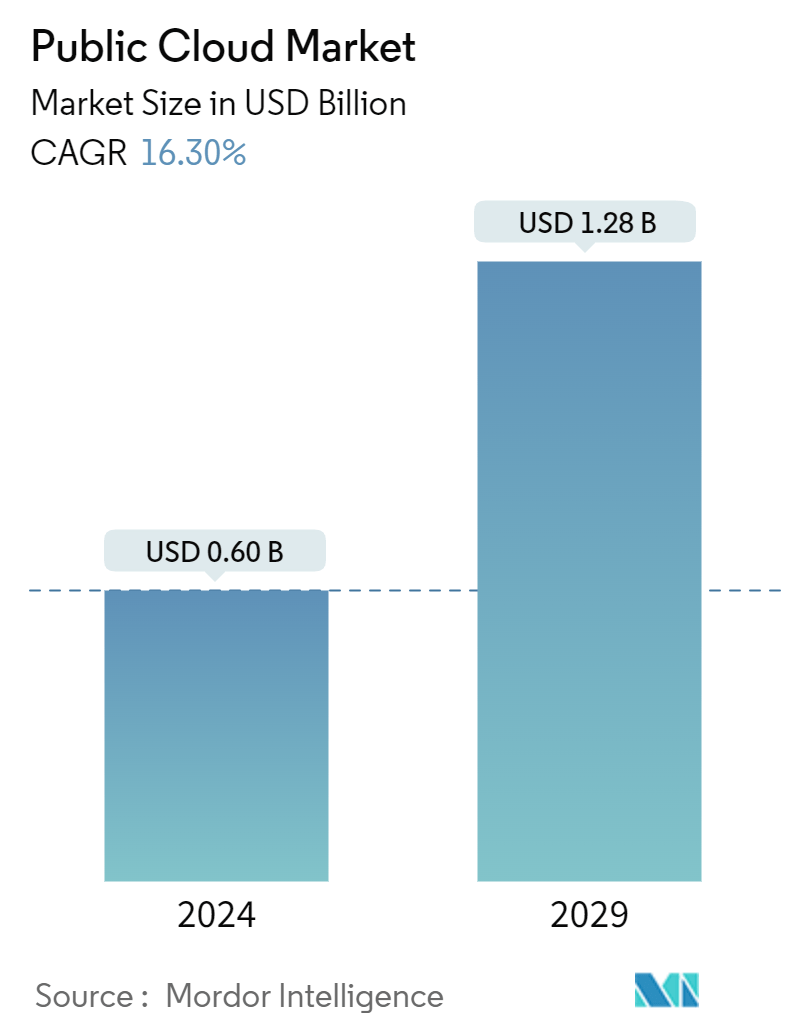Market Size of Public Cloud Industry

| Study Period | 2019 - 2029 |
| Market Size (2024) | USD 0.60 Billion |
| Market Size (2029) | USD 1.28 Billion |
| CAGR (2024 - 2029) | 16.30 % |
| Fastest Growing Market | Asia Pacific |
| Largest Market | North America |
| Market Concentration | Medium |
Major Players
*Disclaimer: Major Players sorted in no particular order |
Public Cloud Market Analysis
The Public Cloud Market size is estimated at USD 0.60 billion in 2024, and is expected to reach USD 1.28 billion by 2029, growing at a CAGR of 16.30% during the forecast period (2024-2029).
One of the primary market drivers for public cloud adoption is the unmatched scalability and elasticity it offers to businesses of all sizes. Traditional on-premises infrastructures often need help to handle sudden spikes in demand, leading to costly overprovisioning or underutilization of resources. Numerous providers allow businesses to scale their resources up or down rapidly in response to changing requirements.
- Public cloud services have transformed the way companies operate their IT budgets. The pay-as-you-go model lets organizations access diverse services without incurring upfront costs for Software and hardware. Traditionally, procuring and operating hardware meant substantial investments, but the cloud's operational expenditure approach changes the financial landscape. In confluence with this, the pay-as-you-go pricing model benefits startups and small businesses with limited capital and allows larger enterprises to optimize their IT spending. Apart from this, it encourages experimentation, as companies try out new ideas without committing to significant expenses, which provides an impetus to the market.
- According to Thales Group, As of 2022, over 60 percent of all business data is stored in the cloud. As businesses progressively move their resources into cloud environments to enhance security, dependability, and business agility, this balance hit 30% in 2015 and has since increased. These factors create a massive growth opportunity for the market-studied vendors to expand their offerings in the coming years. The growing adoption of cloud computing among enterprises also broadens the scope of the studied market. For instance, India-based market vendor Druva Inc. reported that many companies primarily target enterprise data due to a large amount of unstructured data. The company also reported that this data claim accounts for over 80% of the data stored in enterprise storage systems.
- Flexera Cloud Report 2022 surveyed 753 respondents; the company stated that respondents heavily influence SaaS and IaaS/PaaS decisions; 78% are involved in SaaS decisions, compared to 77% of respondents active in public cloud decisions. This is similar to how respondents actively manage continuing usage and costs for public cloud IaaS, PaaS, and SaaS (69 %). Further, according to the Fortinet Cloud Security Report 2022, Cloud users guarantee that the cloud is delivering on the promise of adaptable capacity and scalability (53%), increased agility (50 percent), and improved availability and business continuity (45%) Such massive adoption of cloud solutions would drive the market.
- Moreover, security risks are likely to concern market growth. To date, the third-party executives have handled services with care. Further, the threat of data breaches is always on, which also challenges market progress. The primary purpose of IT governance in the enterprise is process standardization. Traditionally, the need for governance originated to provide supervision and direction.
- Whether the existing systems are private or public clouds, managing a hybrid cloud incorporating multiple systems will be more complex. According to the RightScale State of the Cloud report, cloud governance was the top challenge for enterprises and SMBs. Enterprise respondents cited it as a concern, mainly because they have a multi-cloud strategy.
Public Cloud Industry Segmentation
A public cloud is a type of computing where resources are offered by a third-party provider through the Internet and shared by businesses and individuals who want to use or purchase them. Some public cloud computing resources are free, while customers may pay for other resources through subscription or pay-per-usage pricing models.
The public cloud market is segmented by deployment (software-as-a-service (SaaS), platform-as-a-service (PaaS), infrastructure-as-a-service (IaaS)), by organization size (SME's organization, large organization), by end-user industry (BFSI, healthcare, government, manufacturing, IT and telecom), and by geography (North America, Europe, Asia Pacific, Latin America, Middle East and Africa). The market sizes and forecasts are provided in terms of value in USD for all the above segments.
The market sizes and forecasts are provided in terms of value USD for all the above segments.
Public Cloud Market Size Summary
The public cloud market is experiencing significant growth, driven by its ability to offer unparalleled scalability and flexibility to businesses of all sizes. This shift from traditional on-premises infrastructures to cloud solutions is largely due to the pay-as-you-go model, which eliminates the need for substantial upfront investments in software and hardware. This model is particularly beneficial for startups and small businesses with limited capital, as well as larger enterprises looking to optimize their IT spending. The increasing adoption of cloud computing is transforming IT budgets and encouraging experimentation, as companies can try new ideas without committing to large expenses. The market is further bolstered by the growing need for enhanced security, reliability, and business agility, as more organizations move their resources to cloud environments.
North America is a leading region in the public cloud market, with a strong presence of cloud microservice vendors and a high demand for advanced technologies. The region's firms are increasingly adopting public cloud architecture to improve agility, efficiency, and scalability in sectors like finance, e-commerce, and travel services. The market is moderately consolidated, with major players like Amazon Web Services, Microsoft, and Google Cloud investing in strategic partnerships and product developments to expand their offerings. These companies are also focusing on enhancing their services to meet the rising demand for cloud solutions, as evidenced by recent collaborations and expansions in various regions. The ongoing growth in the number of small and medium enterprises, particularly in the United States, presents further opportunities for market players to develop new public cloud solutions and capture market share.
Public Cloud Market Size - Table of Contents
-
1. MARKET INSIGHTS
-
1.1 Market Overview
-
1.2 Industry Attractiveness - Porter's Five Forces Analysis
-
1.2.1 Bargaining Power of Suppliers
-
1.2.2 Bargaining Power of Buyers
-
1.2.3 Threat of New Entrants
-
1.2.4 Threat of Substitutes
-
1.2.5 Intensity of Competitive Rivalry
-
-
1.3 Assessment of the Impact of COVID-19 on the Market
-
Public Cloud Market Size FAQs
How big is the Public Cloud Market?
The Public Cloud Market size is expected to reach USD 0.60 billion in 2024 and grow at a CAGR of 16.30% to reach USD 1.28 billion by 2029.
What is the current Public Cloud Market size?
In 2024, the Public Cloud Market size is expected to reach USD 0.60 billion.

